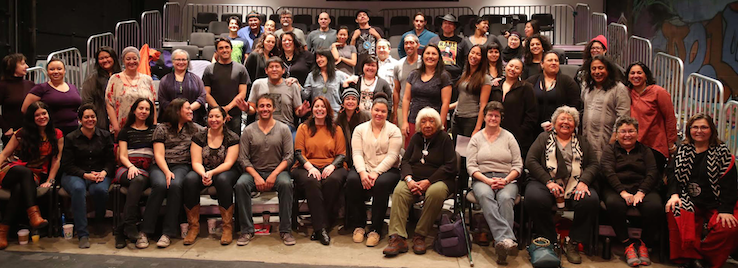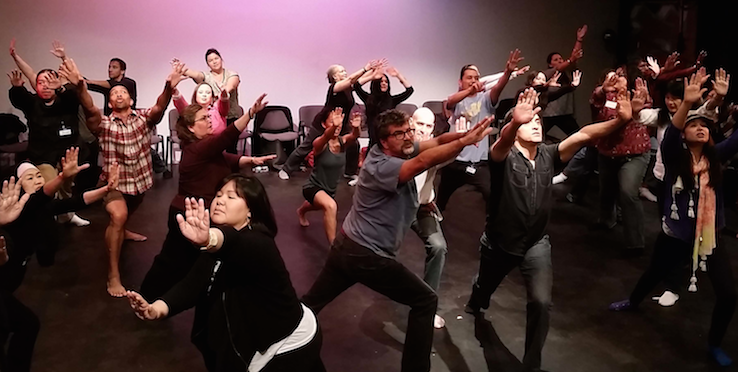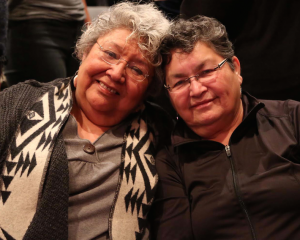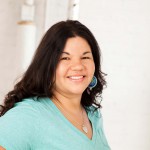Lumhe “Micco” Sampson presenting his workshop, “Hoop Dance Teaching: Indigenous Circles of Leadership”
at the Indigenous Artists Gathering. Photo: Ashley Minner, 2015.
Article by: Ashley Minner, Lumbee Tribe of North Carolina
Alternate ROOTS Executive Committee Member (Baltimore, MD)
Way back in deepest, darkest winter — on February 24th, to be exact — a message from ROOTS member Andrea Assaf appeared in my inbox and brightened my day. It was a special invitation to attend an Indigenous Artists Gathering in Minneapolis, MN as a representative of ROOTS.
The invitation, from Pangea World Theater and Art2Action Inc., in partnership with the First Peoples Fund and New England Foundation for the Arts (NEFA) read:
“It is an honor to invite you to an Indigenous Artists Gathering for theater and performance practitioners (a component of the National Institute on Directing and Ensemble Creation). The intent of this intensive weekend convening is to gather a focused group of colleagues who are interested in collaborative exchange and professional development in a peer-learning environment, and who would like to participate in a group visioning process. We are inviting specific individuals who have experience in theater or performance creation, directing, ensemble leadership, pedagogy, and/or training programs; and who are interested in contributing to the field, and to the evolution of the National Institute…
During the pilot phase of developing the National Institute for Directing and Ensemble Creation — which is dedicated to increasing cultural and gender equity in the theater field — we collaborated with several national theater and performance networks, to gather input on the needs of directors and ensemble leaders, especially artists of color and women directors, and to envision the structure and curriculum of a National Institute. However, it was glaringly obvious that many of the existing theater networks did not include any Native-identified, First Peoples or Indigenous artists, and that currently, there are very few opportunities for Indigenous artists working in theater, or original/contemporary performance forms, to gather. So we endeavored to commit resources to creating a gathering for Indigenous theater/performance artists, in order to exchange and envision forward steps together.”
We were further advised:
“This is a completely collaborative, participatory convening. There is no external agenda except to bring together all of you amazing, creative, powerful artists, to explore needs, assets, creative processes, and issues that matter to you with regard to your work as artists and culture bearers — together. We respectfully request your ideas, visions, suggestions and recommendations. What do YOU wish to share to the group? What do YOU think is most important to discuss? I will be in charge of gathering your input and structuring a schedule based on your leadership.”

Nearly fifty artists came together at Pangea World Theater for the Indigenous Artists Gathering. Photo: Nicole Devine, 2015.
So, this happened…in March, in Minneapolis. And I was there. It was amazing and important for many reasons.
First, let me ‘splain something to you about Native people. Supposedly, there are six degrees of separation between any two people in the world. I mean, “everyone and everything is six fewer steps away, by way of introduction, from any other person in the world, so that a chain of ‘a friend of a friend’ statements can be made to connect any two people in a maximum of six steps.”[i] In the vast networks of our Native communities, the average degrees of separation are one — as in everyone already knows everyone (or so it seems) — and two and three as in two people may not already know each other, but invariably know the other person’s auntie/friend/ex/grandfather’s cousin-twice-removed etc.
For example, upon arrival at our hotel in Minneapolis, one of the first people I met was Mary Kathryn Nagle, who was in from New York. She is the sister of a friend and fellow community artist back home in Baltimore, Rebecca Nagle. Both girls are Cherokee, originally from Oklahoma. Not impressed? Try this: all of us participants were blessed with the opportunity to interact with the members of Spiderwoman Theater, the first Native American women’s theater troupe. The ladies who founded Spiderwoman Theater — sisters Muriel, Gloria, and Lisa — are Kuna. Although these ladies themselves were born and raised in New York City, their father and their tribe, the Kuna, are from Kuna Yala, the San Blas Archipelago off the coast of Panama. Within minutes of meeting Ms. Muriel, we established that one of my close friends in Colón (Panama!) is her cousin and we were chatting away on Whatsapp.
Then there was my friend Rosy Simas (Seneca), who had just treated my girls (The Native American After School Art Program) to a class with her at Dance Place in Washington, D.C. a few weeks before. And there was Lumhe “Micco” Sampson (Seneca/Muscogee), who had also just visited us and performed with our friend Frank Waln (Sicangu Lakota) in College Park, Maryland.
Present at this historic, unprecedented convening were representatives of Native communities from Alaska all the way to Panama. This is not to say that all Native communities were represented, nor that everyone who should have been there was there. But it was a good start, with space and time to discuss who was absent from the conversation and how to get us all together in the future.
Particularly exciting to me was the fact that the region now known as the U.S. South was well represented. In fact, the Lumbee Tribe of North Carolina was represented — and not just by me! Also in attendance was Layla Rose Locklear (Lumbee), who performs with the Ulali Project.
Through the convening, all of the representatives of all of the communities became personally connected. Degrees of separation between ourselves — our struggles, our triumphs, our best practices, our wisdoms — were removed. Threes and twos became ones.
Our first evening together, we met at the home of Meena Natarajan and Dipankar Mukherjee of Pangea World Theater, where we shared a delicious meal that was lovingly prepared for us by Meena and Dipankar themselves. This was a beautiful way to enter into community in Minneapolis, to remember that we were with family.
Our official time together began with an acknowledgment of the people in whose homeland we were convening, a prayer and a blessing given by elder Sharon Day (Ojibwe). Following that, we had a round of introductions that took most of the first day. Sitting in a large circle, we were asked to share something of ourselves other than our professional titles and affiliations. Mr. William S. Yellow Robe Jr. (Assiniboine) remembers, “There are a lot of tribal politics involved in Native theater and they do have to be addressed. The very first day when they asked us to introduce ourselves with something about our personal lives rather than our careers, that eliminated a lot of posturing.”
All of our meeting time was filled with participatory presentations — movement, theater games, discussions — yet there was also time for quiet and reflection. On the third evening, Pangea’s space was opened to us so that we could share our work with each other. This was an incredible treat featuring dance, theater, film, spoken word, and musical performance. We were even able to experience the work of some of the elders of Native theater, through vintage footage presented by such living legends as the Spiderwoman Theater sisters and Margo Kane (Cree-Saulteaux). Joy Harjo (Muscogee) also gave a reading of one of her theater pieces with assistance from several other artists who were there. They even welcomed me to share my visual art. Everyone was completely unpretentious and generous with their craft, time, and attention, even though our sharing went on until after midnight.
On our final day together, we discussed ways to move forward. Ideas were generated as to what folks would like the group to be or become, as well as what it should not be. The space and the opportunity for this gathering was graciously created and held by non-indigenous allies. All parties agreed that native folks can and should move the work forward, and everyone present was willing to help.
Also, before our time together was up, information about funding and touring resources and opportunities were shared with the group by Native advocates who work within the organizations offering the resources. Folks are already taking advantage of these opportunities. My sister Brandie MacDonald (Chickasaw/Choctaw) spoke for First Peoples Fund, Ms. Quita Sullivan (Montaukett) spoke for NEFA and Andrea Assaf, Quita, and myself spoke for Alternate ROOTS.
One time after a break, Mr. William S. Yellow Robe Jr. brought folks back to the discussion as a Pow Wow MC would call dancers back to the circle. He announced into the mic, “All you Native artists please return to the theater! We’re getting ready for Grand Entry! We’re going to have an Intertribal. And all you FBI agents, get the hell out of here!” (Meeting him was my favorite part of the experience.)
Mr. Bill, as I call him, says:
“I was really surprised about the communication of people — surprised and pleased — how some were very willing to talk. The whole last day of business, we talked about moving forward. One element that I thought was great was that of reconciliation because there are still a lot of artists who were left out [at this gathering and in other circles]. There needs to be a way of bringing them back in, and there needs to be a way of addressing… uh… old wounds — if you will — or old conflicts, so people can move forward. One of the things we’ve never done — and we came close this time — was to air out all the issues [amongst ourselves]. Part of this reconciliation is that we have to identify our pasts. Everyone in the theater wants to move forward and I agree that has to happen, but let’s not forget our past. Let’s not forget those that broke ground that made it possible for all of these other groups to exist.”
Mr. Bill also says, “As they create a list of all the Native artists and new artists and playwrights and actors, they should also create a memorial listing of all those Native artists who made contributions in the past, who are no longer alive in this world, so we can honor our past as well.”
At the start of ROOTS Week 2014, I was asked by Executive Director Carlton Turner to open our meeting space by acknowledging the people indigenous to the land our event occupies each year. As an organization committed to social and economic justice working to dismantle all forms of oppression everywhere, this was a significant acknowledgement. In the legacy of settler colonialism — which, by definition, never really ends — Native people have to disappear. They are a “‘present absence’ in the U.S. colonial imagination, an ‘absence’ that reinforces, at every turn, the conviction that Native peoples are indeed vanishing and the conquest of Native land is justified.”[ii] Being that blood was shed on the land upon which we stand at ROOTS Week, and being that we meet in the ancestral home of the Cherokee, and being that the Cherokee are still there (!), we must acknowledge and engage that history and presence. We should acknowledge Native communities wherever we live and work on this land.
The South, particularly east of the Mississippi, is largely devoid of opportunities specifically for Native peoples, including Native artists — even from Native organizations. This is partly due to the pervasive belief that the Indian Removal Act of 1830 was actually a “success” and there are no Indians east of the Mississippi, and partly due to myriad other political reasons rooted in white supremacy and the interest of our capitalist state. Well, guess what. There is a real opportunity for Alternate ROOTS to be an ally and an organizational leader by more persistently engaging with the Native populations in our service region. Talk about sources of knowledge on strategic resistance!
I am proud that ROOTS is a partner of the National Institute for Directing & Ensemble Creation that made a way for this historic Indigenous Artists Gathering to happen. I am honored to have been invited as a representative of ROOTS. You can expect to see an increase in the Native presence at ROOTS Week 2015. By the way, one of our 2015 Visual Arts Scholars is a fellow Lumbee, Jessica Clark.
Get ready, y’all. #idlenomore
(For additional information on the Idle No More Movement, read this article.)
Many thanks to all of the organizations and everyone who took part in making possible this huge step to move the work forward.
________
Ashley Minner is a community based visual artist from Baltimore, Maryland. A member of the Lumbee Tribe of North Carolina, she has been active in the Baltimore Lumbee community for many years. Her involvement in her own community informs and inspires her studio practice. Ashley is currently a PhD student in American Studies at University of Maryland College Park where she is studying vernacular art as resistance in tri-racial isolate communities of the U.S. South and Global South.
[i] “Six Degrees of Separation” Wikipedia. Accessed June 23, 2015.
[ii] Kate Shanley, as quoted in “Indigeneity, Settler Colonialism, White Supremacy.” Racial Formation in the Twenty-first Century. Edited by Daniel Martinez HoSang, Oneka LaBennett, and Laura Pulido (University of California Press, 2012).







[…] READ THE FULL ARTICLE HERE! […]